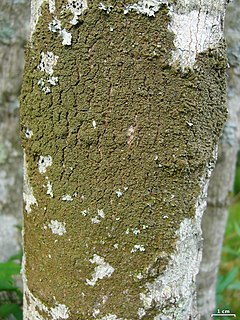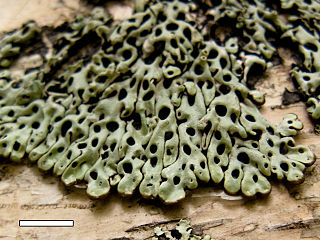
Parmelia is a genus of medium to large foliose lichens. It has a global distribution, extending from the Arctic to the Antarctic continent but concentrated in temperate regions. There are about 40 species in Parmelia. In recent decades, the once large genus Parmelia has been divided into a number of smaller genera according to thallus morphology and phylogenetic relatedness.

The Parmeliaceae is a large and diverse family of Lecanoromycetes. With over 2700 species in 71 genera, it is the largest family of lichen-forming fungi. The most speciose genera in the family are the well-known groups: Xanthoparmelia, Usnea, Parmotrema, and Hypotrachyna.

Allocetraria is a genus of lichenized fungi in the family Parmeliaceae. It consists of 12 species, with a center of distribution in China.

Hypogymnia is a genus of foliose lichens in the family Parmeliaceae. They are commonly known as tube lichens, bone lichens, or pillow lichens. Most species lack rhizines that are otherwise common in members of the Parmeliaceae, and have swollen lobes that are usually hollow. The lichens usually grow on the bark and wood of coniferous trees.

Myelochroa is a genus of foliose lichens in the family Parmeliaceae. They are commonly known as axil-bristle lichens. It was created in 1987 to contain species formerly placed in genus Parmelina that had a yellow-orange medulla due to the presence of secalonic acids. Characteristics of the genus include tightly attached thalli with narrow lobes, cilia on the axils, and a rhizinate black lower surface. Chemical characteristics are the production of zeorin and related triterpenoids in the medulla. Myelochroa contains about 30 species, most of which grow on bark. The genus has centres of distribution in Asia and North America.

Melanohalea is a genus of foliose lichens in the family Parmeliaceae. It contains 30 mostly Northern Hemisphere species that grow on bark or on wood. The genus is characterized by the presence of pseudocyphellae, usually on warts or on the tips of isidia, a non-pored epicortex, and a medulla containing depsidones or lacking secondary compounds. Melanohalea was circumscribed in 2004 as a segregate of the morphologically similar genus Melanelia.

Melanelixia is a genus of foliose lichens in the family Parmeliaceae. It contains 15 Northern Hemisphere species that grow on bark or on wood. The genus is characterized by a pored or fenestrate epicortex, and the production of lecanoric acid as the primary chemical constituent of the medulla. Melanelixia was circumscribed in 2004 as a segregate of the related genus Melanelia.

Xanthoparmelia is a genus of foliose lichen in the family Parmeliaceae. Xanthoparmelia is synonymous with Almbornia, Neofuscelia, Chondropsis, Namakwa, Paraparmelia, and Xanthomaculina. This genus of lichen is commonly found in the United States, as well as Australia, New Zealand and Ecuador.

Menegazzia is a genus of lichenized fungi containing roughly 70 accepted species. The group is sometimes referred to as the tree flutes, honeycombed lichens, or hole-punch lichens. The most obvious morphological feature of the genus is the distinctive perforations spread across the upper side of the thallus. This makes the group easy to recognise, even for those not particularly familiar with lichen identification.

Bryoria is a genus of lichenized fungi in the family Parmeliaceae. Many members of this genus are known as horsehair lichens. The genus has a widespread distribution, especially in boreal and cool temperate areas.

Hypogymnia occidentalis, commonly known as the lattice tube lichen, is a species of foliose lichen in the family Parmeliaceae. It is found in North America, where it grows on the lower trunks of conifers, particularly Douglas-fir.
Hypogymnia laxa is a species of foliose lichen in the family Parmeliaceae. Found in the Chinese Himalayas, it was described as a new species by Bruce McCune in 2003. The type specimen was collected from the Jiaozi Snow Mountain in Luquan County (Yunnan), at an elevation of 3,750 metres (12,300 ft). Here it was found growing on the bark and wood of Abies, Pinus, and Rhododendron. The lichen is characterized by a thallus with soredia, the presence of physodalic acid in the medulla, and rimmed holes on the lower surface. This latter feature distinguishes it from the morphologically similar Hypogymnia pseudophysodes, which always has unrimmed holes.
Hypogymnia pseudocyphellata is a rare species of foliose lichen in the family Parmeliaceae. Found only in the Chinese Himalayas, it was described as a new species by Bruce McCune and Erin Martin in 2003. The type specimen was collected from the Tian Chi alpine lake in Shangri-La City (Yunnan), at an elevation of 3,750 metres (12,300 ft). Here it was found growing on the bark and wood of fir. The lichen is characterized by the presence of whitish pseudocyphellae on the tips of the lobes ; rimmed holes; lobes that are narrow and separated; and a complex secondary chemistry with several unknown chemical compounds as well as barbatic acid, but without diffractaic acid.
Hypogymnia diffractaica is a species of foliose lichen in the family Parmeliaceae. Initially reported from Southwest China, it was described as a new species by Bruce McCune in 2003. The type specimen was collected in Jiulong County, at an elevation of 3,000 metres (9,800 ft). Here it was found growing on the bark and wood of Rhododendron; it has also been recorded on birch. It is characterized by its slender lobes, the rimmed holes on the lower surface, and the presence of the chemical diffractaic acid as the main secondary metabolite in the medulla. It has a lower surface that is expanded and puffed out. Hypogymnia hengduanensis, the only other Hypogymnia species containing diffractaic acid as the main medullary substance, is quite similar in appearance, but can be distinguished from H. diffractaica by the presence of isidia. It also tends to grow at slightly lower elevations. In 2018, H. diffractaica was recorded from Bhutan.
Hypogymnia congesta is a rare species of foliose lichen in the family Parmeliaceae that is found in China. It was formally described as a new species by Bruce McCune and Chicita Culberson in 2003. The type specimen was collected near Wei Den village, behind Lou Ma Deng Mountain in Weixi County (Yunnan), at an elevation of 3,000 metres (9,800 ft). There it grows on the bark and wood of conifers and bamboo. Hypogymnia congesta has a brown to brownish-grey foliose thallus measuring up to 8 cm (3.1 in) long or broad, with a cartilage-like texture. Its ascospores measure 7–8 by 5.0–5.5 μm. The lichen is chemically distinct, containing virensic acid and physodic acid, but lacking physodalic acid. Virensic acid is otherwise unknown from the genus Hypogymnia.
Hypogymnia bulbosa is a species of foliose lichen in the family Parmeliaceae. Found in Southern China, it was described as a new species by Bruce McCune and Li-Song Wang in 2003. The type specimen was collected from the Zi ben Mountain in Cao County (Yunnan). There it was found growing on a spruce stump. It has also been recorded growing on the bark and wood of fir, willow, and Rhododendron. It is known to grow at elevations ranging between 2,800–3,800 metres (9,200–12,500 ft), generally in conifer forests. The lichen is characterized by features such as the rimmed holes on the lower surface of the thallus, the presence of the chemical physodalic acid, and the adundant budding.

Parmelia ernstiae is a species of foliose lichen in the family Parmeliaceae. It occurs in Europe.
Allocetraria corrugata is a species of foliose lichen in the family Parmeliaceae. It is found in high-elevation locations in Yunnan, China, where it grows on rocks with mosses.

Hypogymnia flavida is a species of foliose lichen in the family Parmeliaceae. It is found in mountainous locations of east Asia, where it grows on the bark and wood of woody plants. It has a relatively large yellowish thallus.
Hypogymnia papilliformis is a rare species of foliose lichen in the family Parmeliaceae. Found in China and the Russian Far East, it was formally described as a new species in 2015 by Bruce McCune, Svetlana Tchabanenko, and Xin Li Wei. The type specimen was collected by the second author in the Lazovsky Nature Reserve at an altitude of 600 m (2,000 ft); here, in a mixed conifer–broadleaved forest, it was found growing on Korean pine. The lichen has also been recorded from a mixed forest in the mountains of Shaanxi Province in China, at an altitude of 1,500 m (4,900 ft). The specific epithet papilliformis alludes to the papillose texture of the upper thallus surface. Secondary compounds that occur in Hypogymnia papilliformis include atranorin, and physodic acid as major metabolites, and minor amounts of 2'-O-methylphysodic acid and vittatolic acid.












